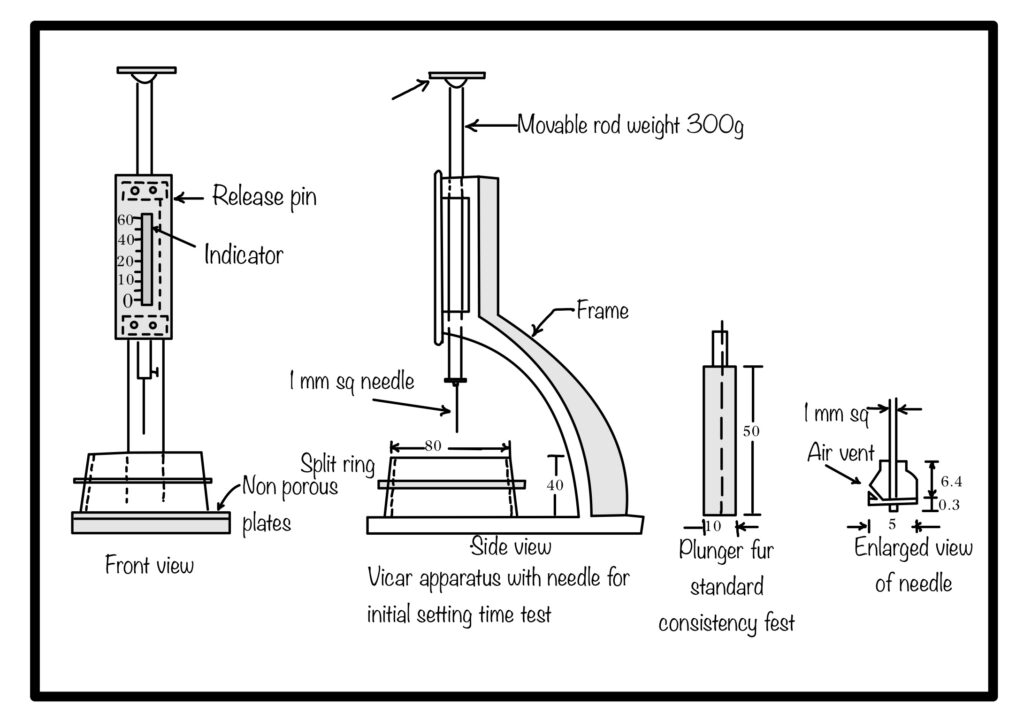Cement is the gem ingredient of a concrete mix, it is a binder which sets, hardens and creates a bond between the other materials in concrete and helps to bind them together within its setting time . Before using any cement in the concrete , it is quite obvious we should check the quality and properties of cement. It is the most costly ingredient used in a concrete mix so it is important to use it wisely.
Consistency of cement
Consistency is a general term to indicate the degree of fluidity or the degree of mobility. It determines the quantity of water required to initiate the chemical reaction in the cement paste with a desired degree of fluidity.
Some of the test which is important to conduct before using cement in the mix is given below:
- Fineness test
- Consistency test
- Setting time test
- Strength test
- Soundness test
- Heat of hydration test
- Tensile strength test
- Chemical composition test
In this post my main focus is to discuss about the setting time test. Basically there are two types of setting test done in cement paste. The setting time of cement regulates the setting time of concrete as a whole. It is important to consider the setting time when we intend to transport the concrete from one place to another, we delay or accelerates the setting time by adding specific admixtures.
Initial setting time
Initial setting time of concrete is defined by the conducting the setting time test in cement paste. When the cement paste just starts hardening it is called as initial setting time. Experimentally the value of initial setting time is calculated as the time between the water is initially mixed with cement to the time when an 1 mm needle fails to penetrate the cement paste at a depth of 5 mm to 7 mm from the bottom of the mould, placed in the vicat’s apparatus.
Final setting time
When the cement paste has hardened and gain some initial strength and shape of the formwork. After this time duration it is difficult to change the shape of the concrete mix, and also the formwork can be removed for some simple structures. Experimentally the value of final setting time is calculated as the time between the water is initially mixed with cement to the time when an 1 mm needle makes an impression on the cement paste and 5 mm needle will not leave any impression when it is dropped.
Experimental procedure
Both the initial and final setting time is carried out at the laboratory and in the same apparatus using different needles. Don’t worry will explain in detail about the different apparatus used for this experiment.
Apparatus required for setting time tests
- Vicat’s apparatus
- Mould – depth 40 mm, top width 80 mm, bottom width 100 mm
- Needle used for initial setting time – 1mm2 cross sectional area.
- Needle used for final setting time – 5 mm width annular attachment.
- Glass plate
- Measuring cylinder
- Weighing balance
- Stop watch
- Tray
- Trowel

Procedure:
Before going into the setting time test it is required to check the consistency of cement, so that the appropriate water content can be known to give a normal consistency (P).
- Take 400 g of cement and prepare a paste by adding 0.85 P of water by weight of cement.
- An ideal mixing time of cement and water is 3 – 5 mins. Start the stop watch before pouring the first drop of water on to the cement. Note the start time as T1.
- Fill the vicat mould with the cement paste, don’t forget to place the glass plate below the mould. Fill the mould completely with the cement such that it is uniformly filled, level the top surface and give a smooth finish.
- Place this mould on to the vicat apparatus fitted with the needle of 1 mm thickness.
- Lower the needle gently such that the needle is just touching the cement paste and release the needle , intially the needle will penetrate. Repeat this steps after every 2 – 3 mins. We should repeat this step till the needle fails to penetrate for about 5 mm depth measured from the bottom of the mould.
- Note this time as T2.
- Then replace the needle with the annular attachment needle (5 mm thickness).
- Then repeat the step 5 by the using different needle., till the needle fails to make any impression in the top surface of test block.
- Note this time as T3.
$$ Initial\, setting\,time = T2 – T1$$
$$ Final\, setting\,time = T3 – T1$$
Hope this blog helped you for calculating the setting time of concrete.

Android Apps
⭐️ ⭐️ ⭐️ ⭐️ ⭐️ 1000+ | 400,000 + Downloads (Cumulative)
At eigenplus, our goal is to teach civil engineering students about structural analysis and design starting from the fundamental principles. We do this with the help of interactive android applications and accompanying web articles and videos.
Our apps have helped more than 400 thousand students across the world to understand and learn the concepts of structural engineering. Check out our apps on the google play store.